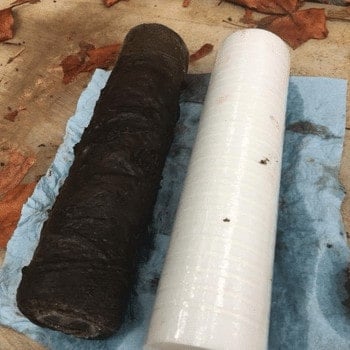Noticing black gunk in your water filter? Don’t panic — it’s usually not as scary as it looks.
In most cases, it’s caused by harmless minerals or leftover carbon. But sometimes, it points to something deeper, like iron in your well, mold growth, or even issues with your septic system.
Let’s unpack what’s normal, what’s not, and how to fix a blackened filter fast — so you can get back to clean, safe water.
⚡ Quick Takeaways
- 🪨 Common Culprit: Iron and manganese deposits are often to blame — especially in well water.
- 🔄 Backwashing Might Help: Try a backwash cycle first to flush out mineral buildup.
- 🧼 Filter Change Time? If your filter’s overloaded, swap it out to restore flow and performance.
- 🔍 Watch for Mold or Carbon Leaks: Black particles might be from a cracked carbon cartridge or filter mold — check carefully.
- 🧪 Water Testing = Smart Move: A test can reveal if you’re dealing with iron, bacteria, or something else entirely.
- 🛠️ Prevention Is Key: Stay on top of maintenance, especially if your system handles well water.
🧪 What’s Turning Your Filter Black?
If your whole-house water filter suddenly looks like it’s dipped in soot, one of these culprits is likely at play:

- 🪨 Mineral Deposits: High levels of iron or manganese can oxidize and leave dark residue. Manganese, in particular, may create a black, slimy buildup.
- 🌋 Black Sediment: Some regions have naturally dark minerals in the soil — like black sand or smoky quartz — that can end up in your filter.
- 🌿 Organic Matter: Decaying algae or silt can darken your water over time, especially if your well is drawing in runoff or organic debris.
- 🧲 Carbon Particles: If you’re seeing black specs, your carbon filter might be cracked or overused — and shedding its media.
- 🦠 Mold: Rare but possible, especially if filters sit in warm, damp environments or aren’t changed often enough.
💡 Pro Tip: If the discoloration is sudden or extreme, don’t guess. Start by inspecting your system — but plan on a water test for peace of mind.
🔍 Troubleshooting a Blackened Filter

When your filter turns black, it’s not always obvious why. But with a little investigation, you can usually pin down the issue and fix it fast.
✅ Step 1: Inspect the Filter Housing
Check the filter housing for leaks, cracks, or signs of carbon dust. If you’re seeing black specs inside a multi-stage system, there may be a cracked carbon cartridge or loose filter media. Remove the cartridge and inspect the O-rings, gasket, and housing threads.
If you’ve got a carbon system, this quick guide on carbon dust explains what’s normal — and what’s not.
✅ Step 2: Check for Sediment Build-Up
If your sediment filter is coated in black, replace it and watch what happens. If the black color returns quickly, you may have a steady source of iron or manganese in your water.
This can be common in private wells — you might want to read up on sediment issues here.
✅ Step 3: Look for Leaks or Mold
Carbon filters and softeners that backwash can sometimes trap moisture and encourage mold if the environment is humid or the system isn’t flushed regularly.
Check around the base, under the housing, and behind the unit. If you find any signs of mold or musty odors, follow proper handling tips — especially for cartridge filters.
Need help? This article covers what to do if you suspect mold in your water filter.
💡 Good to know: If you spot signs of black residue outside your filter housing or see it floating in your water, it could be coming from upstream — like your well, pipes, or appliances — not the filter itself.
🔧 Could It Be The Plumbing?

Sometimes the culprit isn’t the filter at all — it’s what’s upstream.
Start by peeking inside your pressure tank, water heater, or even the tub of your washing machine. Black particles can build up in any of these spots and wind up in your filter later. A flashlight and quick look inside the filter housing or bottom of the washer drum can reveal a lot.
If your home has older galvanized pipes, they could be flaking rust or releasing iron that oxidizes into black specks. Replacing problem sections or flushing your system can clear out the buildup.
🧠 Pro Tip: If you’re on a well, black sediment can come from the well itself. Running dry, pulling in silt, or a cracked casing can all cause changes.
🧪 When to Test Your Water

When in doubt, get the facts. Testing your water is the most reliable way to figure out what’s behind a blackened filter — and whether it’s something harmless like carbon dust or a more serious contaminant like iron or bacteria.
If your water test comes back showing:
- ✅ No major contaminants: The issue likely lies in the filter itself.
- ⚠️ Elevated iron or manganese: You may need to upgrade your filter or add an iron-specific system.
- 🚨 E. coli or other bacteria: Time to inspect your well casing or septic — fast.
💡 Good to know: Annual well water testing isn’t just smart — it’s recommended by the CDC. To learn more, read our guide on well water testing.
🚽 Check Your Septic System (Yes, Really)

If you’re on a septic system and your filter’s turning black, it might not be a coincidence. A leak or failure could be sending more than water into your plumbing — and some of it may end up in your filter.
🔍 Red flags to look for:
- 🌿 Extra-lush grass over the septic area
- 🫢 Sewage smell in the yard or home
- 🚽 Slow drains or gurgling pipes
- 💧 Standing water around the tank
If any of these sound familiar, don’t take chances. Switch to bottled water and call a septic pro immediately — this kind of contamination can get serious fast.
👉 For more warning signs, check out our guide to common well water problems.om pumping to repair.
🛠️ Should You Check the Well?
If your filter’s turning black and you’ve ruled out other issues, it might be time to take a closer look at your well system.
Wells are made up of several components — the pump, casing, cap, and pressure tank — and if anything cracks or fails, it can let in dirt, silt, or even bacteria. Sometimes it’s a slow build-up of gunk… other times it’s a sign the well is starting to run dry.
🔍 What to watch for:
- Water looks muddy or cloudy
- Pressure drops or fluctuates
- Filter clogs happen faster than normal
While you can troubleshoot some of this yourself, it’s often faster (and safer) to bring in a licensed well contractor.
🧼 How to Prevent It Next Time

The best way to deal with a blackened filter? Prevent it from happening in the first place. A little maintenance goes a long way.
🛠️ Simple Ways to Stay Ahead:
- 🔄 Swap filters regularly – Don’t let sediment and gunk pile up. Most cartridges should be changed every 6–9 months.
- 💨 Flush backwashing systems – Even automatic ones need an occasional reset to prevent microbial buildup. Learn more about backwashing here.
- 💧 Control humidity – Mold loves moisture. If your system’s in a damp basement, consider adding a dehumidifier.
- ⚙️ Use KDF media – Some carbon filters come pre-loaded with KDF, which fights bacteria and extends filter life.
- 🧪 Test your water every year – Especially for well users. It’s the best way to spot new problems before they grow.
💡 Pro Tip: If you’re seeing repeat filter clogs or color changes, your well could be struggling or running dry.
🤔 Quick FAQs

❓Can city water really turn a filter black?
Yes, but it’s rare. While municipal water is treated, aging infrastructure or recent pipe repairs can stir up sediment, rust, or bacteria. If you notice sudden changes, reach out to your utility — and test your water to be safe.
❓Can drinking carbon dust make you sick?
Nope — it’s not harmful. In fact, carbon dust is just a harmless byproduct of activated carbon filters. That said, it can look unsettling. If it’s excessive, your cartridge might be damaged and need replacing.
❓Do water softeners remove iron particles?
Some can, but most only handle light iron levels — around 3 ppm. If your water has higher concentrations, you’ll likely need a dedicated iron filter instead.
 130 people found this helpful. Was this guide helpful to you?
130 people found this helpful. Was this guide helpful to you? 

